They added 1.6 million more workers to the labor force, even as the overall labor force has not been able to recover to pre-pandemic trend.
By Wolf Richter for WOLF STREET.
The tight labor market over the past two years has had an amazing effect on people who have a disability: An additional 1.55 million were working in January compared to the pre-pandemic January 2020, up by 27%, and an additional 1.62 million were in the labor force compared to January 2020, up by 26%, according to the employment data by the Bureau of Labor Statistics today.
And according to the Social Security Administration, the number of people who applied for disability benefits, and the number of people who received disability benefits, both dropped to the lowest levels in many years.
In January, there were 32.6 million people aged 16 and over who had a disability, according to the Bureau of Labor Statistics. Lots of times, you see the word “the disabled,” but that’s wrong. Many of them are not “disabled.” The correct term is “people with a disability.” They may be vision impaired, or they returned from a war with a limb blown off, or they have some disease. A lot of disabilities are the natural result of getting old. Many of the lucky ones that make it to 80 years have some kind of disability, and yet some still work and earn money, and you’ll find some in the US Congress, making good money too.
Others are not in the labor force. They may be elderly and retired. Some simply cannot work because of their disability, and some of them receive disability benefits. Others are wealthy and don’t need to work; others are full-time students, etc.
The number of people with a disability in the labor force started spiking with the tight job market in early 2021 which encouraged people with a disability to go look for work, and thereby join the labor force. The new flexibility by employers about working from home was likely a big contributor.
A record 7.85 million people with a disability were in the labor force in January, meaning there were either working or actively looking for a job in January. This was up by 24%, or by 1.62 million, from January 2020!
At the same time, in this tight labor market, companies, beset with difficulties in hiring people to fill the record number of job openings, began opening more doors to people with a disability. (None of the data here is seasonally adjusted. To reduce some of the month-to-month variations, I used three-month moving averages):
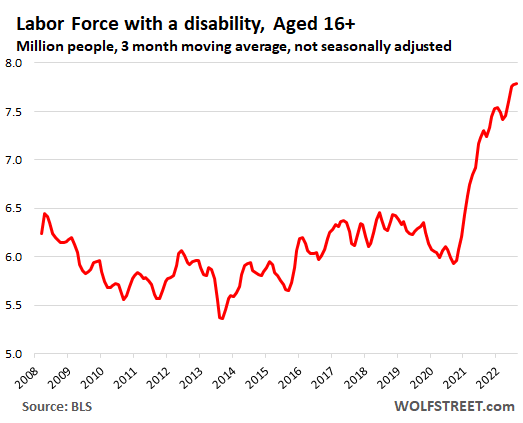
The number of people with a disability who were employed in January spiked by 27% from January 2020, to 7.29 million in January — with December at 7.37 million having been the highest in the data from the BLS going back to 2008:
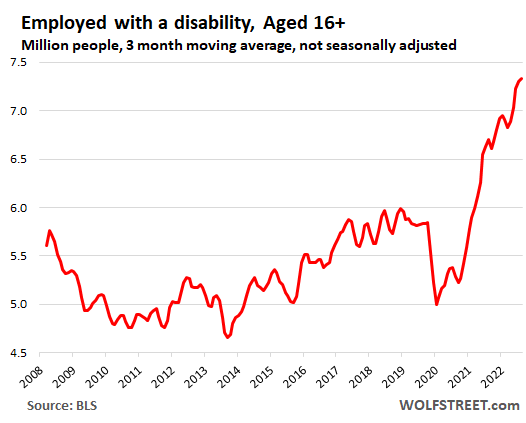
The unemployment rate for people with a disability — people who were unemployed and were actively looking for a job — dropped to a record low of 5.0% in December, not seasonally adjusted, amid a surge of seasonal hiring by the retail industry before the holidays. In January, those seasonal jobs ended, and the unemployment rate rose of 7.1%.
The three-month moving average of the unemployment rate, which irons out the month-to-month fluctuations, dropped to 6.0% in January, the lowest in the data going back to 2008.
However, the unemployment rate for people with a disability remains far higher than for the overall labor force (3.5% in December and 3.4% in January, seasonally adjusted), attesting to the difficulty people with a disability face in getting hired even in a hot labor market.
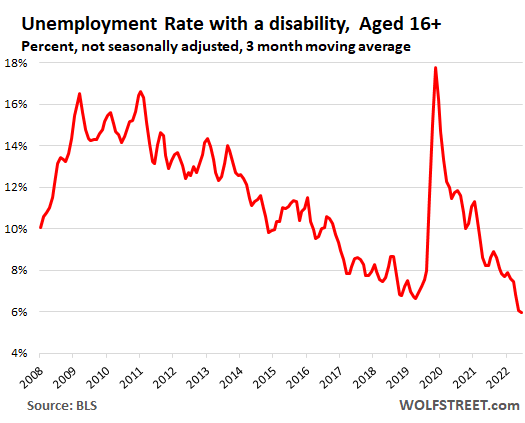
People with a disability who want to work face a harsh reality: Finding a job is tougher for them than for people without a disability. And so the unemployment rate is always higher. But as the labor market got historically tight, and working from home took off, employers were encouraged to hire people with a disability, and people with a disability were encouraged to look for a job. The results are great to see.
Here is the thing: Over the past two years, people with a disability added 1.62 million more workers to the labor force, even as the overall labor force has not been able to recover to pre-pandemic trend due to excess deaths, a wave of retirements, and other factors, which has been dogging this labor market for the past two years.
People applying for and receiving disability benefits.
There is another aspect to disability: People who apply for disability benefits with the Social Security Administration, and then the people who actually receive disability benefits.
During the Great Recession, in a phenomenon that has long been discussed, applications for disability benefits spiked. Many of them might have been people with a disability who tried to find a job but couldn’t as the labor market went into crisis, and so they gave up and applied for disability benefits. Applications for disability benefits, received by Social Security Administration field offices, peaked in 2009 at the peak of the unemployment crisis, with 2.94 million applications.
Every year since then, the number of applications dropped and in 2022 fell to 1.80 million applications at the field offices, the lowest since 2003:
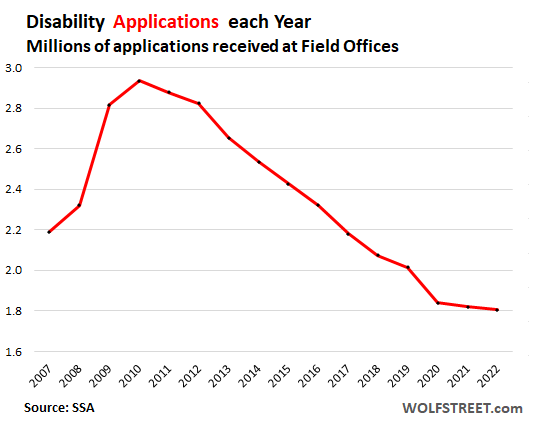
The number of people who actually received disability benefits peaked in 2014 at 9.0 million beneficiaries and has since then dropped every year. In 2022, it dropped to 7.6 million, the lowest since 2008:
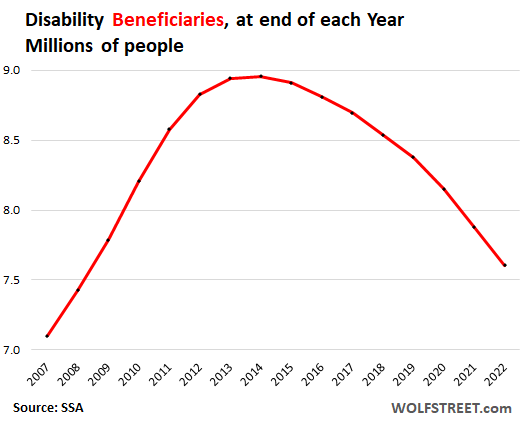
Enjoy reading WOLF STREET and want to support it? You can donate. I appreciate it immensely. Click on the mug to find out how:
![]()


This is great news. Thanks for covering this story Wolf. Mainstream could give a hoot about this.
I would imagine disabled make excellent employees in general.
As one with two fairly serious disabilities, I applaud the specificity with which you differentiate between having a disability and being disabled.
While in general later in my career, by accumulated skills were focused on what I COULD DO, and far outweighed the disability.
Earlier I could not obtain several desired jobs due to enhanced danger to my self and others, but employers were usually very appreciative of my work ethic and tried to find some position for me…
Also later, when I was hiring folks, I made it plain to my bosses that I would not tolerate irrational rejection of folks with disability if their potential was appropriate AND the had a good attitude, which almost all did have.
wish I could comment, but at 61 I’m going on saturday to go caulk apartment
will be on my knees, on 2nd floor and it’s painful just going up and down
maybe I ought to apply
joedidee,
“maybe I ought to apply”
Do you know how to read???
Read VintageVNvet’s comment. Make an all-out effort. You can do it.
It was all about how he was able to keep working into advanced age despite his disabilities.
Nothing in it about applying for disability benefits.
joedidee,
“wish I could comment,”
LOL you DID comment.
HD sells a Husky kneeling pad that’s easily 2″ thick. It’s a lifesaver for old knees.
Also, if you use Dynaflex230 instead of Alex Plus, you won’t need the kneeling pad again next month to redo it.
I did oilfield work until I was 75. And I have two new hips now. Never did I think about applying for any “assistance” when the hips started going south at around 65 years old. Still have the OE knees! Man up! LOL!
Thanks for your comments
THIS WAS SARCASM
and you all fell for it
happy psyops day
joedi – if you scan the comments/commenters completely you might see the value of using an ‘/s’ switch. Playing at ‘psyops’ in this crowd will only lead to your comments being considered generally to be less-so and probably ignored. Peace.
may we all find a better day.
Not relevant to Article:
Cramer has declared that we are in a bull market!
It can mean that his financers had taken bullish positions a month back and now want to exit it by dumping it on the retail crowd. So I feel that Feb could be 5% to 10% lower.
It’s also a wakeup call for Fed: QT ain’t working. Expect significant pain ahead from both inflation and higher rates.
It’s a wakeup call for working class: All this rinsing didn’t work. You will be rinsed more and you would get even lesser for more work!
God bless America.
The number of work from home jobs has greatly increased the employability of many disabled workers. Shows companies can become flexible with unemployment at 3.4%.
This is Great News, sometimes life does in fact deal you bad hand. What you do with it in the game of life set you apart from those who appear to be dealt all the aces. Those who play the hand well win even though they lose.
This should be shouted from the roof top as we all need Good news and to be acknowledged for our skills in the game.
Thank you for reporting this, it makes you a champion for the champions
Some good news. Employers learned that people work well from home. This gives more opportunities to many people.
I love seeing participants from folks with disabilities working as well as technology has provided more opportunities for those that may need different opportunities and also a signal that the labor force is tight.
For decades, ~5% unemployment was considered “full employment” within a normal and healthy economy with the normal churn of business birth/growth/decay.
“The three-month moving average of the unemployment rate, which irons out the month-to-month fluctuations, dropped to 6.0% in January, the lowest in the data going back to 2008.”
Wow! Who knew? Thank you for doing the grunt work to present this.
You’re priceless.
In 2020, during the pandemic, disable people were let go, because the risk for impaired people was too high. Unemployment rate with disability spiked > 2009 & 2010 highs. High beta week, high beta nadir for the disable. If SPX turn red the impaired SPX might be on disability for several months.
RRP will support S&P.
Your article relates to a long overdue change in perception of the value of the disabled. The labor shortage begins a new paradigm where people are now considered a limited resource. Barriers to employment will recede along with the arbitrary ones, such as backgrounds checks, insurance requirements etc will allow even felons who have skills back in. Profits will shrink but 40 percent margins (Apple, etc) were never sustainable in a capitalist system.
Look ! It’s the ghost of Rush Limbaugh !
These charts are the creations Jeff Zients & WolfStreet.
Considering the steep drop of 1.14 million fewer applicants between 2009 and 2022, would it be safe to say that this entirely accounts for the subsequent drop in beneficiaries that followed with the difference being made up through attrition as the oldest beneficiaries pass? Is there anything in the data that would suggest anyone is giving up their disability benefits to return to the labor force?
You’re looking at it backasswards. The drop in APPLICATIONS is what you need to look at. Fewer people applied after the Great Recession because more were able to find work as the job market improved. That is the meaningful number.
People with a disability have the hardest time getting hired. They face an immense uphill battle. So when an employment crisis breaks out, as during the Great Recession, they’re in much greater difficulties than people without disability.
I see. You can’t infer much about the relationship between applicants and those that continue to collect benefits. That makes sense.
I’m NOT a person with a disability, I am DISABLED!. I was born with a rare disorder that affects EVERYTHING in my body. I have lived with excrutiating pain for almost 39 years! Debilitating fatigue and a compromised immune system where my body can NOT fight infections. I am literally house/bedbound!
I feel as though you are saying that most people with a disability can work. Kinda putting down people like me who can’t. I’d much rather be outside, possibly working and enjoying life, not be lying on my heating pad 24/7!
“I feel as though you are saying that most people with a disability can work.”
I have no idea how you got that. Read the article!
I spent my career working with challenged individuals both physically and/or mentally in Orthotic and Prosthetics and later in the Behavioral Science field.
in addition to the many work benefits due to their challenges such as perspective, work ethic, humility, etc.. there are other economic benefits such as:
Work Opportunity Tax Credits (WOTC): The
WOTC provides a direct federal tax credit of $2,400 per every individual with a disability hired.
The USA was pioneering with mobilizing and involving these folks and their talents in the workforce.
In my college classes (I teach), the number classified as persons with disabilities has increased quite a bit. As I am aging, I can appreciate what it means, as I am beginning, by degrees, to experience disabilities. But my mind and skills are sharp as ever. I am thrilled to continue as a contributing member of society.
This reminded me ask, is the same phenomenon observed in the elderly? Are people working longer, retiring later, and are the elderly benefitting from the tight employment market? Ageism is definitely a problem in some industries just wondering if that has changed. Where would I go to find these answers?
1) People with disability entered the labor force.
2) Applications peaked in 2010, but people on disability peaked at 9M
in 2014. Their number is down from 9M to 7.6M = 1.4M.
3) Few expired since 2014, few frauds, few entered the labor force.
4) People on military disability entered the labor force (a different group?).
5) People on disability get their checks on top of their salaries.
Articles such as this one are why I visit Wolf Street. No where else would this topic be handled with such lucidity — if even attempted at all.
Hats off to you Wolf. You’re a rare one.
Pure wisdom dispensed daily. Where else would you find this enrichment?
I met a homecare worker on disability. She was allowed to work a few hours a week even though she was on SSDI.
Would appreciate more details about how many people apply for SSDI, how many receive benefits, how long the process took, if attorneys were needed to get SSDI, etc.
The hoops people have to jump through – okay – it’s complicated to ensure the people who need it get it.
But at what cost? Everyone I’ve spoken to ends up needing an attorney, especially during the appeal period.
I just received a packet of documents to fill out. Annoying but hey, that’s the system. BUT BUT BUT on the very last page out of 13, it states that if you don’t respond within a week or two, they cancel your application because they believe you don’t want to pursue it.
THAT IS SHAMEFUL- some people with disabilities need time to fill out the forms, which are complicated. THIS IS A SIMPLE FIX THAT MUST BE CHANGED!
Clearly, the only conceivable reason they have this (on the LAST PAGE) is to give people a hard time.
Been on SSDI for past 10 years. Permanently visually disabled 14 different eye operations.
I made good $ so I get the max amount.
I can only make $1300 month and still get SSDI.
There’s a program “ticket to work” that last almost t year where you can work with no income limits to see if can go back.
At 65, I’m 62 your technically no longer on SSDI but then retirement ss income.
You don’t need a lawyer to apply for SSDI. I didn’t.
If your disability is granted say a year before when first deemed disabled the lawyer get 30% of that lump sum. I my case would of been over 10k.
The approval is 1 of 3 get it who apply.
The big benefit is after 2 years on disability you get Medicare which can save your thousands each year.
I wonder if the drop off in people getting SSDI is due to aging out is turning 65?
SSA rejects approx. 95% of all SSDI applications, forcing applicants to appeal.
Appeal process is slow. Anywhere from 18 to 24 months before a decision is rendered. Final stage of appeal is a hearing with an Administrative Law Judge (ALJ). Approx. 98% of appeals are approved by ALJ’s. Back payment of benefits to the original eligibility date are granted, which the SSA awards in a lump sum.
Most appellants hire a lawyer. Worth the investment. Feds have a max cap of $6000 on legal fees. Fees are calculated as a percentage of the back payment lump sum amount. Feds cap the max legal fee at $6000.
Six months after monthly benefit payments commence, SSA automatically enrolls the SSDI recipient in Medicare and will start deducting Medicare Part B premiums from the monthly benefit amount.
Hope this helps.
This has to be interpreted as nothing but good news overall. There are quite a few people with disabilities that had an even more difficult time getting hired for jobs and being able to keep those jobs pre-pandemic due to the accommodations needed for them to work that many employers didn’t want to pay for. Now that WFH is an established part of employment, this allows people with disabilities not only more pay than they would receive from disability payments but a sense of purpose as well, as most of them actually want to work.
Some conditions are intermittent and unpredictable. The flexibility of work from home absolutely gets people who want to work but can’t do regular hours without breaks or absences back into the workforce.
The new and expensive migraine drugs, which do not work for everyone and can have nasty side effects, are game changers for many people forced to drop out of the workforce or cut hours. But then you have to trust in Big Pharma as one of their guinea pigs.
I was hoping you would provide us a chart of the total: “CNP, 16-64, With a Disability”.
We need that series to figure out which of the two options are true:
Either:
1) There is an increase in the number of people “with a disability”
2) There is no change in the number of people “with a disability”
Here you go.
The population with a disability increased by 6% since Jan 2020, small compared to the 27% spike in employment of people with a disability over the same period, and the 26% spike of people with a disability in the labor force.
The population with a disability increased in general because of the vast number of boomers are getting older and therefore have age-related disabilities, many of them still working despite their disabilities; see some of them here in the comments. You can see that starting in around 2012, when the oldest boomers turned 67. There are other obvious reasons in the more recent increase, including how covid created additional disabilities with older people, and other health issues. But the increase is small (6%) compared to the big spike in the labor force (26%) and employment (27%) of people with a disability.
What you don’t tell anyone is that people on disability ultimately do NOT receive enough money to survive on so they are FORCED to go find a job to pay monthly living expenses simply to get by. I am not surprised at this as the government doesn’t want legitimately disabled people to collect any benefits because that is money not being placed in their greedy pockets.
Came here for this.
Absolutely, WFH is allowing a lot of people with disabilities (yo!) to stay in the workforce. But given the cost of living has soared, its not like there’s an alternative choice for many. Rent alone is killing us, plus groceries, electric, even while working the average lower middle class person is scraping by.
I’m taking years off my life and spiraling deeper into health problems trying to stay employed as a ‘normie’. Can’t use health care anymore because of the cost, probably not a bad thing. The alternative is going on SSDI/public welfare and dragging my family down into deep poverty and housing/food insecurity. Figure I have enough in me to get the kids into adulthood and out of the house before SHTF, so shortened life span it is, not like I’ll be able to retire anyway.
Just curious how much of a factor the sunsetting of COVID-era relief programs may have played a role. Even in (most of) California, you can now be evicted for not paying rent, beginning on 1 January.
It’s almost like if you pay people not to work, don’t be surprised if they don’t. Take those so-called safety nets away and look what happens.